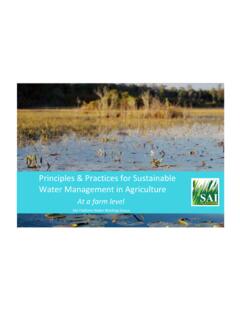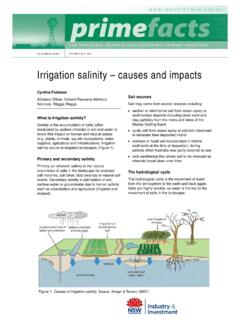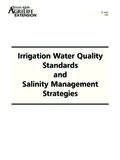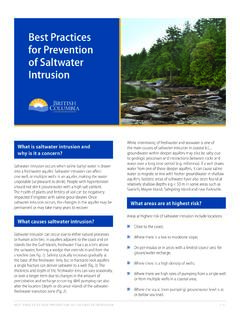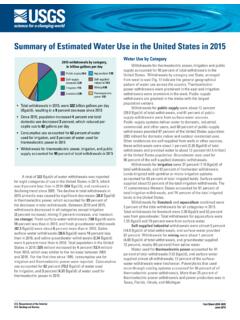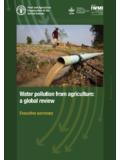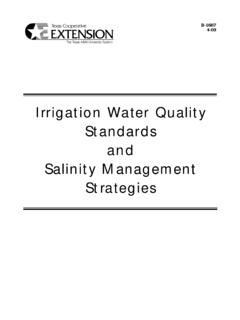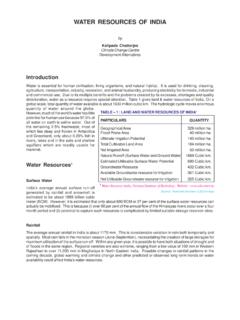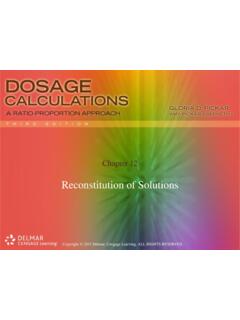Transcription of Irrigation Guide - USDA
1 (210-vi-NEH, September 1997)vPart 652 Irrigation GuideIrrigation GuideUnited StatesDepartment ofAgricultureNaturalResourcesConservatio nServiceNationalEngineeringHandbook(210- vi-NEH, September 1997)viPart 652 Irrigation GuideIssued September 1997 The United States Department of Agriculture ( usda ) prohibits discrimina-tion in its programs on the basis of race, color, national origin, sex, religion,age, disability, political beliefs, and marital or familial status. (Not all pro-hibited bases apply to all programs.) Persons with disabilities who requirealternative means for communication of program information (Braille, largeprint, audiotape, etc.) should contact usda s TARGET Center at (202) 720-2600 (voice and TDD).
2 To file a complaint, write the Secretary of Agriculture, Department ofAgriculture, Washington, DC 20250, or call 1-800-245-6340 (voice) or (202)720-1127 (TDD). usda is an equal employment opportunity employer.(210-vi-NEH, September 1997)iPart 652 Irrigation GuidePrefaceIrrigation is vital to produce acceptable quality and yield of crops on aridclimate croplands. Supplemental Irrigation is also vital to produce accept-able quality and yield of crops on croplands in semi-arid and subhumidclimates during seasonal droughty periods. The complete management ofirrigation water by the user is a necessary activity in our existence as asociety. Competition for a limited water supply for other uses by the publicrequire the Irrigation water user to provide much closer control than everbefore.
3 The importance of irrigated crops is extremely vital to the public' 's management of Irrigation water requires using the best informationand techniques that current technology can provide in the planning, design,evaluation, and management of Irrigation systems. Support for many of thevalues included in this chapter come from field research, established designprocesses, and many system designs and evaluations over many years. Fieldevaluations must always be used to further refine the planning, design,evaluation, and management process. This design Guide in the NaturalResources Conservation Service (NRCS), National Engineering Handbookseries provides that current Guide , Part 652, is a Guide .
4 It describes the basics and process forplanning, designing, evaluating, and managing Irrigation systems. It pro-vides the process for states to supplement the Guide with local soils, crops,and Irrigation water requirement information needed to plan, design, evalu-ate, and manage Irrigation Guide , Part 652, is a new handbook to the family of references inthe NRCS, National Engineering Handbook series. It is written for NRCS employees who provide technical assistance to the water user with con-cerns for both water quantity and quality. Other technical personnel forFederal, State, private, and local agencies will also find the Guide useful as abasic reference when providing technical assistance relating to planning,designing, evaluating, and managing Irrigation systems.
5 College and univer-sity instructors will also find the Guide useful as a classroom addition to the Irrigation Guide (part 652), chapters in the NationalEngineering Handbook Irrigation section (now part 623) describe: Soil-plant relationships and soil water properties that affect move-ment, retention, and release of water in soil Irrigation water requirements Planning farm Irrigation systems Measurement of Irrigation water Design of pumping plants Design criteria and design procedures for surface, sprinkler, andmicro Irrigation methods and the variety of systems for each methodthat can be adaptable to meet local crop, water , and site conditionsand Irrigation concerns(210-vi-NEH, September 1997)iiPart 652 Irrigation GuideAcknowledgmentsPart 652, Irrigation Guide , is an addition to the National Engineering Hand-book series.
6 The document was initially prepared by Elwin A. Ross, irriga-tion engineer, NRCS, Engineering Division, Washington, DC, (retired) withprimary input and review from Leland A. Hardy, Irrigation engineer,Midwest National Technical Center, NRCS, Lincoln, Nebraska, (retired).Principal NRCS staff who contributed to the development and review ofthis publication were:John Brenner, Irrigation engineer, North Platt, NebraskaJerry Walker, Irrigation engineer, Temple, TexasCarl Gustafson, state conservation engineer, Amherst, MassachusettsDavid Nelson, assistant state conservation engineer, Amherst,MassachusettsJohn Dalton, agricultural engineer, Bozeman, Montana (retired)Jim Suit, state conservation engineer, Bozeman, MontanaState conservation engineers coordinated a multidiscipline (representingsoils, agronomy, water quality, and water management) review in all J.
7 Carmack, national water management engineer, (retired),Ronald L. Marlow, water management engineer, NRCS, Washington, DC,and Thomas L. Spofford, Irrigation engineer, NRCS, National water andClimate Center, Portland, Oregon provided leadership and and publication production assistance were provided by the Techni-cal Publishing Team, NRCS, National Cartography and Geospatial Center,Fort Worth, Texas. Final technical review was provided by Elwin A. Rossand Leland A. Hardy.(210-vi-NEH, September 1997)iiiPart 652 Irrigation GuideIrrigation GuideContents:Chapter 1 IntroductionChapter 2 SoilsChapter 3 CropsChapter 4 water RequirementsChapter 5 Selecting an Irrigation MethodChapter 6 Irrigation System DesignChapter 7 Farm Distribution ComponentsChapter 8 Project and Farm Irrigation water RequirementsChapter 9 Irrigation water ManagementChapter 10 Conservation Management Systems and Irrigation PlanningChapter 11 Economic EvaluationsChapter 12 Energy Use and ConservationChapter 13 Quality of water SupplyChapter 14 Environmental ConcernsChapter 15 Resource Planning and Evaluation Tools and WorksheetsChapter 16 Special Use Tables, Charts, and ConversionsChapter 17 Glossary and ReferencesIndex(210-vi-NEH.)
8 September 1997)iiiPart 652 Irrigation GuideIrrigation GuideContents:Chapter 1 IntroductionChapter 2 SoilsChapter 3 CropsChapter 4 water RequirementsChapter 5 Selecting an Irrigation MethodChapter 6 Irrigation System DesignChapter 7 Farm Distribution ComponentsChapter 8 Project and Farm Irrigation water RequirementsChapter 9 Irrigation water ManagementChapter 10 Conservation Management Systems and Irrigation PlanningChapter 11 Economic EvaluationsChapter 12 Energy Use and ConservationChapter 13 Quality of water SupplyChapter 14 Environmental ConcernsChapter 15 Resource Planning and Evaluation Tools and WorksheetsChapter 16 Special Use Tables, Charts, and ConversionsChapter 17 Glossary and ReferencesIndexPart 652 Irrigation GuideIntroductionChapter 11 7(210-vi-NEH, September 1997)Chapter 1 IntroductionContents:1 and objective1 and energy conservation1 conservation, water quality, and pollution abatement1 the guide1 3(a) Using Irrigation procedures.
9 1 3(b) Using worksheets .. 1 Guide outline1 4(a) General .. 1 4(b) Soil- water -plant data .. 1 4(c) Irrigation and distribution systems .. 1 4(d) Irrigation planning and management .. 1 5(e) Special tools .. 1 of computers1 supplement1 6 Part 652 Irrigation GuideIntroductionChapter 11 1(210-vi-NEH, September 1997)Chapter water and energyconservationConservation Irrigation is an integral part of a com-plete farm management program of soil, water , air,plant, and animal resources. It is a principal consider-ation in the NRCS Conservation Management Systemapproach to conservation planning on irrigated crop-land, hayland, and pastureland. Irrigation must becomplemented with adequate management of nutri-ents and pesticides, tillage and residue, and water management results in conservation ofwater quantities, maintenance of onsite and offsitewater quality, soil chemical management (salinity,acidity, applied fertilizers, and other toxic elements),and Irrigation related erosion the farm manager, benefits must justify the costsof purchasing and operating the Irrigation system andthe time required to adequately operate, manage, andmaintain the Irrigation system while leaving a reason-able return on investment.
10 For the groundskeeper,park or landscape superintendent, nursery grower, orhomeowner, Irrigation must maintain the desiredgrowth of grass, ornamentals, flowers, and gardencrops while minimizing costs, labor, inefficient wateruse, and nutrient and chemical costs of energy used for pumping makesevery acre-inch of excess water a concern to manyirrigators. Improving and maintaining pumping plants, Irrigation equipment, Irrigation application efficien-cies, and following an Irrigation scheduling programcan lead to significant reductions in pumping costs of farm equipment, fuel, seed, fertil-izer, pesticide, and Irrigation equipment also makeevery Irrigation and field operation a financial concernto the farmer.










